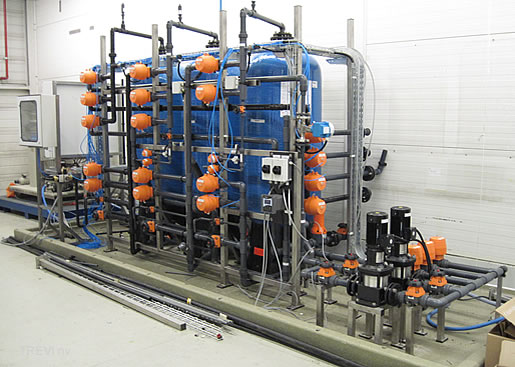Purpose
Removal of ions, hardness, specific cations or anions
Concentration of cations and anions
Principle
During the production of process water as well as during the treatment of industrial wastewater, in some cases it is necessary to remove some specific ions or substantially all ions out of the water. This is possible with a separation technique such as ion exchange. With this technique very low residual concentrations of ions can be obtained in the treated water .
As the name suggests ions present in the water are exchanged to harmless counter-ions such as Na+, H+, Cl- or OH- during this process. Determined by the choice of the exchange resins the exchange can be selective or not selective. Once the capacity of the ion exchange resins is saturated it is regenerated with a concentrated solution of counterions. By this regeneration process the ion exchange resins are brought back to their original state. The regeneration liquid contains the desorbed ion load and requires a dedicated wastewater treatment. In particular cases the resins are not regenerated on site and are externally disposed.
Applications
Softening or demineralisation of process water
Extraction of heavy metals from wastewater
Recovery of precious metals or catalysts from wastewater
Recovery of acids or bases from rinse waters
Purification of products
Configurations
An ion exchange plant consists essentially of one or more pressure vessels filled with ion exchange material. This can be a synthetic resin, or a mineral such as zeolite or alumina. A whole range of materials is available for various applications. If the feed water contains suspended solids a preceding filtration technique is recommended to prevent clogging.
Example of realisation

Sand filter followed by cation and anion filter
Operational costs
To determine the operationals cost not only the initial investment has to be considered but also the cost of the regeneration chemicals, treatment of the regeneration water, as well as the replacement of the ion exchanger itself. For these reasons ion exchangers are often only used in wastewater treatment processes for effluent polishing or reuse aplications. Reverse osmosis is increasingly seen as an alternative for the demineralisation of water.
Approach Trevi
Trevi will first examine whether any savings can be realised through source reduction. This allowed Trevi to install ion exchangers to achieve a closed loop system in certain industrial processes, saving water and chemicals. Ion exchange can also be applied to remove small concentrations of metals from the effluent prior to the discharge point.